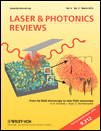
Laser & Photonics Reviews
Scope & Guideline
Illuminating the Future of Photonics Research
Introduction
Aims and Scopes
- Laser Technology:
Research on various types of lasers, including solid-state, fiber, and semiconductor lasers, focusing on their design, operation, and innovative applications. - Photonics and Optoelectronics:
Studies related to photonic devices, including waveguides, modulators, photodetectors, and integrated optics, emphasizing their role in communication and sensing technologies. - Nanophotonics and Metamaterials:
Exploration of light-matter interactions at the nanoscale, including the development of metamaterials and nanostructures to manipulate light for various applications. - Quantum Photonics:
Investigation of quantum phenomena in photonic systems, including quantum communication, entanglement, and single-photon sources, driving advancements in quantum technologies. - Biomedical Applications:
Research focused on the application of lasers and photonics in healthcare, including imaging techniques, phototherapy, and diagnostics. - Materials Science and Engineering:
Studies addressing the development and characterization of new materials for photonic applications, including organic, inorganic, and hybrid materials.
Trending and Emerging
- Integrated Photonics:
There is a significant increase in research related to integrated photonic devices, focusing on their miniaturization and efficiency for applications in communications and sensing. - Quantum Technologies:
An emerging trend in the journal is the exploration of quantum photonics, including studies on quantum communication systems, quantum computing, and the development of quantum light sources. - Metasurfaces and Light Manipulation:
Research on metasurfaces for manipulating light at subwavelength scales is on the rise, showcasing innovative applications in imaging, sensing, and information processing. - Machine Learning in Photonics:
The integration of machine learning techniques in photonics research is gaining momentum, with applications in design optimization, imaging, and data analysis, reflecting the interdisciplinary nature of current research. - Biophotonics and Medical Applications:
There is a growing emphasis on biophotonics, particularly in areas related to medical imaging and therapeutic applications, highlighting the importance of photonics in healthcare.
Declining or Waning
- Traditional Solid-State Lasers:
Research focused on conventional solid-state laser technologies has decreased as more innovative and efficient laser systems, such as fiber lasers and semiconductor lasers, gain traction. - Basic Laser Physics:
While foundational studies in laser physics remain important, the emphasis on purely theoretical explorations appears to be waning in favor of applied research that demonstrates practical applications. - Optical Coatings:
The frequency of studies specifically devoted to optical coatings and thin film technologies is declining, possibly due to the increasing integration of advanced materials that enhance functionality beyond traditional coatings.
Similar Journals

APPLIED PHYSICS B-LASERS AND OPTICS
Pioneering Discoveries in Laser ApplicationsApplied Physics B - Lasers and Optics, published by Springer Heidelberg, is a renowned journal in the field of applied physics, particularly focusing on lasers and optical technologies. With a solid impact factor, this journal has established itself as a significant source of cutting-edge research, contributing to advancements in both theoretical and practical aspects of the discipline. The journal is indexed in Scopus, boasting a commendable rank of #24 out of 81 in the category of Physics and Astronomy (miscellaneous), reflecting its reputation and the quality of published work. Since its inception in 1994, Applied Physics B has covered a wide array of topics, catering to researchers, professionals, and students engaged in the exploration of innovative optical phenomena and laser applications. This journal not only disseminates vital knowledge but also fosters interdisciplinary collaboration, making it an essential resource for those seeking to stay at the forefront of research in lasers and optics.
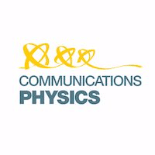
Communications Physics
Illuminating the path of interdisciplinary collaboration.Communications Physics is a premier open access journal published by Nature Portfolio, dedicated to disseminating high-quality research in the field of Physics and Astronomy. Since its inception in 2018, the journal has rapidly established itself as a vital platform for innovative scientific communication, boasting an impressive Impact Factor and achieving Q1 status in the 2023 category of Physics and Astronomy (miscellaneous). With a Scopus rank of #31 out of 243, placing it within the 87th percentile, Communications Physics attracts a global audience of researchers, professionals, and students eager to engage with cutting-edge findings. The journal supports open access, ensuring that research is freely available to the public, which enhances its visibility and encourages broader discussions within the scientific community. Located in Berlin, Germany, Communications Physics aims to bridge the gap between various disciplines within physics, fostering interdisciplinary collaboration and inspiring future research endeavors.

Korean Journal of Optics and Photonics
Advancing Innovations in Optics and PhotonicsKorean Journal of Optics and Photonics is a premier publication dedicated to advancing knowledge in the rapidly evolving fields of optics and photonics. Published by the esteemed Optical Society of Korea, this journal serves as a vital platform for researchers, professionals, and students seeking to disseminate their findings and innovations in areas such as optical engineering, photonics technologies, and application developments. Although the journal does not operate under an Open Access model, it is committed to high-quality peer-reviewed research that contributes significantly to both theoretical and practical advancements in the field. With an increasing focus on interdisciplinary research, the Korean Journal of Optics and Photonics is poised to play a crucial role in fostering collaboration and driving the global conversation on light science and technology. The journal's ISSN is 1225-6285 and it also carries the E-ISSN 2287-321X, ensuring its availability to a wide readership.
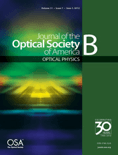
JOURNAL OF THE OPTICAL SOCIETY OF AMERICA B-OPTICAL PHYSICS
Unveiling the Wonders of Optical TechnologiesJOURNAL OF THE OPTICAL SOCIETY OF AMERICA B-OPTICAL PHYSICS, published by Optica Publishing Group, serves as a leading platform for groundbreaking research in the fields of optical physics, atomic and molecular physics, and statistical and nonlinear physics. With an ISSN of 0740-3224 and an E-ISSN of 1520-8540, this esteemed journal has been in circulation since 1984 and is dedicated to advancing the understanding of optical phenomena and related technologies. It holds a commendable position in the academic community, with a 2023 Scopus ranking reflecting its significance—placing it in the top quartile for both Atomic and Molecular Physics and Statistical and Nonlinear Physics. Although it is not an open-access publication, it provides extensive access options to ensure that research is disseminated effectively within the scientific community. This journal is instrumental for researchers, professionals, and students alike, aiming to keep them informed of the latest advancements and trends in optical science. With a convergence of expertise and innovation, JOSA B continues to play a pivotal role in shaping the future of optical research.

Chinese Optics
Illuminating Research in Atomic and Molecular Physics.Chinese Optics is a premier journal dedicated to advancing the field of optics, encompassing research on atomic and molecular physics. Published by the esteemed Changchun Institute of Optics Fine Mechanics & Physics in China, this journal supports the sharing of cutting-edge findings since its inception in 2010. With an ISSN of 2097-1842, it operates within a competitive landscape, currently positioned in Q3 of the category for Atomic and Molecular Physics and Optics, according to the 2023 metrics. While the journal is not open access, it offers a valuable platform for researchers, professionals, and students to explore and contribute to significant discoveries in the realm of optics and light technology. By fostering scholarly communication, Chinese Optics plays a crucial role in bridging theoretical and practical aspects, making it an indispensable resource for those passionate about the optical sciences.

LASER PHYSICS
Pioneering Research in Atomic and Molecular PhysicsLASER PHYSICS is a premier academic journal published by IOP Publishing Ltd, dedicated to the exploration and advancement of fundamental and applied research in the fields of Atomic and Molecular Physics, Optics, Condensed Matter Physics, Industrial and Manufacturing Engineering, and Instrumentation. Since its inception in 1996, the journal has been a vital resource for researchers and professionals, contributing significantly to the collective understanding of laser technology and its applications. With a consistent Q3 ranking across several sub-disciplines in the 2023 categories, LASER PHYSICS is recognized for its rigorous peer-reviewed articles that push the boundaries of current knowledge. Although primarily subscription-based, the journal aims to disseminate high-quality research to enhance the scientific community's collaboration. As the journal continues to shape the future of laser science until 2024 and beyond, it stands as an essential platform for both emerging and established scholars seeking to publish innovative findings in this dynamic field.

JOURNAL OF RUSSIAN LASER RESEARCH
Connecting Theory and Application in Laser ResearchThe Journal of Russian Laser Research, published by Springer, stands as a vital resource for researchers and professionals in the fields of atomic and molecular physics, as well as optics and engineering. With its ISSN 1071-2836 and E-ISSN 1573-8760, this journal has been disseminating groundbreaking research since its inception in 1994, with a dedicated focus on the advancement of laser technologies and their applications. While it currently holds a Q4 classification in both Atomic and Molecular Physics and Engineering categories, its commitment to fostering novel insights and innovative methodologies positions it as a promising platform for emerging studies within these disciplines. Although the journal does not offer open access options, it continues to draw attention with a growing citation index. By publishing diverse research articles, reviews, and critical discussions, the Journal of Russian Laser Research not only enriches academic literature but also serves as a stepping stone for students and professionals seeking to deepen their understanding of laser science and its myriad applications.
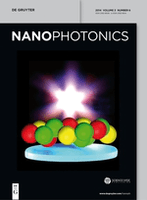
Nanophotonics
Illuminating the Future of Light ManipulationNanophotonics, published by WALTER DE GRUYTER GMBH, is a premier open access journal dedicated to advancing the field of nanophotonics, encompassing cutting-edge research in atomic and molecular physics, optics, biotechnology, and electronic engineering. With a significant impact factor and a notable presence in the top quartile rankings (Q1) across multiple categories, including electrical and electronic engineering, this journal serves as a critical resource for researchers and professionals aiming to explore the latest developments in the manipulation of light at the nanoscale. Since its inception in 2012, Nanophotonics has been an influential platform for disseminating innovative ideas and breakthroughs, offering unrestricted access to its content, thus fostering a collaborative environment conducive to scientific discovery. Located in Berlin, Germany, and with a commitment to promoting the highest standard of scholarly excellence, Nanophotonics continues to shape the future of optical materials and technology, inviting contributions from both established experts and emerging scholars.
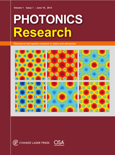
Photonics Research
Advancing Knowledge in Light and MaterialsPhotonics Research, published by Chinese Laser Press, is a premier international journal that aims to disseminate cutting-edge research and advancements in the field of photonics, encompassing areas such as atomic and molecular physics, optics, and materials science. Since its inception in 2013, this journal has established itself as a vital resource for academics and professionals, reflected in its impressive Q1 rankings in both Atomic and Molecular Physics, and Optics (15/224) and Electronic, Optical and Magnetic Materials (26/284) as per Scopus, underscoring its influence within the scientific community. With substantial contributions to the field, Photonics Research continues to foster innovation and collaboration among researchers, serving as an essential platform for the publication of high-quality studies that push the boundaries of knowledge. The journal operates on an open-access model, ensuring that research is readily available to a global audience, thereby enhancing its accessibility and impact. Whether you are a researcher, student, or professional, engaging with this journal offers a significant opportunity to stay at the forefront of photonic technologies and ideas.
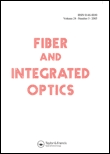
FIBER AND INTEGRATED OPTICS
Fostering Breakthroughs in Optical TechnologiesFIBER AND INTEGRATED OPTICS is a prominent academic journal published by TAYLOR & FRANCIS INC, focusing on the cutting-edge domains of optical and fiber technologies. Since its inception in 1977, the journal has journeyed through expansive developments in the fields of Atomic and Molecular Physics, as well as Electronic, Optical, and Magnetic Materials, boasting a converged publication history extending to 2024. With a solid reputation reflected in its Q3 rankings in both aforementioned categories, FIBER AND INTEGRATED OPTICS serves as an essential platform for researchers, professionals, and students to disseminate and explore innovative findings and methodologies. Although currently not offering Open Access, its scholarly contributions remain invaluable, fostering a deeper understanding and advancements in fiber optic applications and integrated optical systems. Situated in the United Kingdom, the journal continues to attract a diverse global audience, solidifying its significance in contemporary scientific discourse.